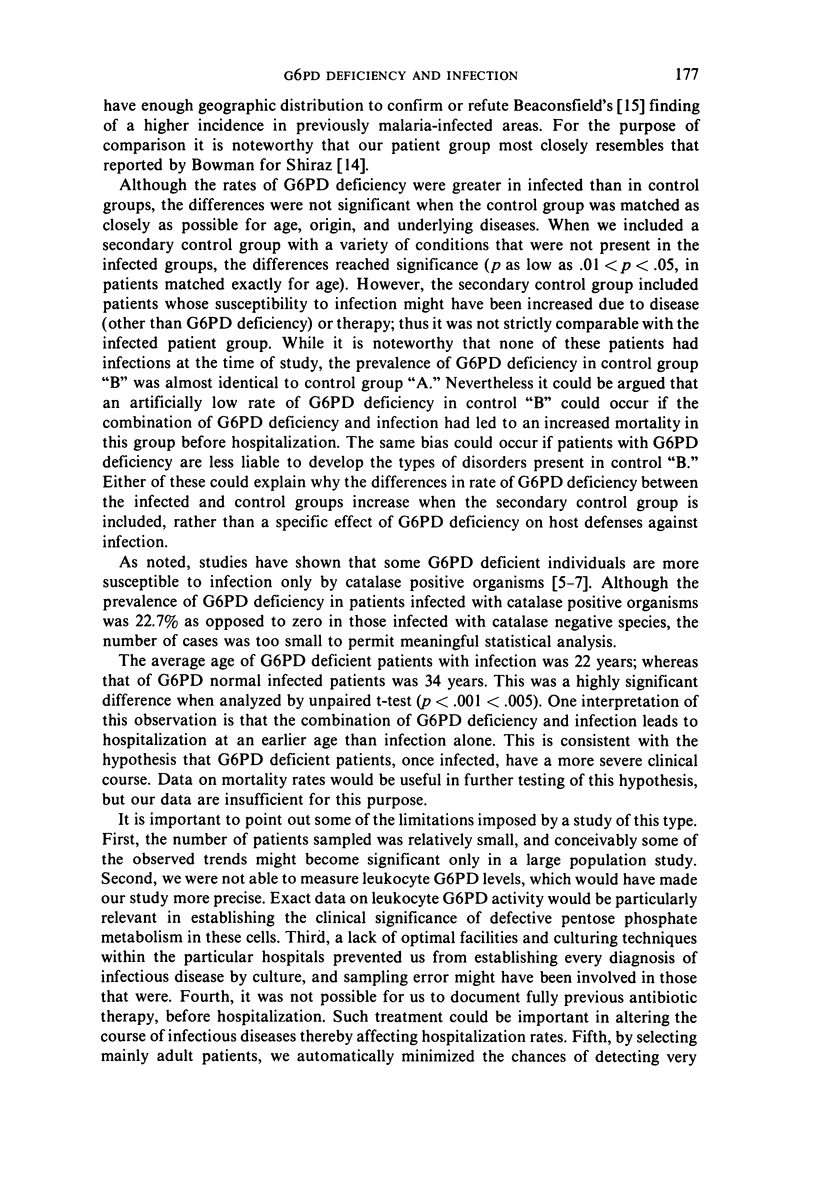Abstract
The Mediterranean variant of glucose-6-phosphate dehydrogenase (G6PD) is functionally deficient and found in a variety of cell types of affected individuals, including both erythocytes and neutrophils. To determine if the presence of this sex-linked gene is associated to any degree with the occurrence of severe bacterial infection, a study of hospitalized male patients in Iran was undertaken. As determined by erythrocyte assay, allele prevalence in male patients with infection was 22% vs. 12% in a patient group matched for the absence of other risk factors for infection and 6% in a second group who had additional risk factors for infection. When the control and patient groups were considered together the difference between the frequency of G6PD deficiency (10.2%) was significantly different from that found in the infected patients (p less than .05). Furthermore, the mean age of infected patients with G6PD deficiency was significantly less than that of infected patients without G6PD deficiency or non-infected control groups. These data suggest that host defenses may be altered in G6PD deficiency so that bacterial infections are more severe. Alternatively, G6PD deficiency and infection might represent concomittant risk factors which lead to hospitalization during bacterial infection. Potential mechanisms by which host defenses might be altered in G6PD deficiency are discussed.
Full text
PDF










Selected References
These references are in PubMed. This may not be the complete list of references from this article.
- Baehner R. L., Johnston R. B., Jr, Nathan D. G. Comparative study of the metabolic and bactericidal characteristics of severely glucose-6-phosphate dehydrogenase-deficient polymorphonuclear leukocytes and leukocytes from children with chronic granulomatous disease. J Reticuloendothel Soc. 1972 Aug;12(2):150–169. [PubMed] [Google Scholar]
- Beaconsfield P., Rainsbury R. G-6-PD deficiency and physiopathologic processes. N Engl J Med. 1968 Apr 18;278(16):914–914. doi: 10.1056/NEJM196804182781624. [DOI] [PubMed] [Google Scholar]
- Beutler E. Abnormalities of the hexose monophosphate shunt. Semin Hematol. 1971 Oct;8(4):311–347. [PubMed] [Google Scholar]
- Cooper M. R., DeChatelet L. R., McCall C. E., LaVia M. F., Spurr C. L., Baehner R. L. Complete deficiency of leukocyte glucose-6-phosphate dehydrogenase with defective bactericidal activity. J Clin Invest. 1972 Apr;51(4):769–778. doi: 10.1172/JCI106871. [DOI] [PMC free article] [PubMed] [Google Scholar]
- Frischer H., Bowman J. E., Carson P. E., Rieckmann K. H., Willerson D., Jr, Colwell E. J. Erythrocytic glutathione reductase, glucose-6-phosphate dehydrogenase, and 6-phosphogluconic dehydrogenase deficiencies in populations of the United States, South Vietnam, Iran, and Ethiopia. J Lab Clin Med. 1973 Apr;81(4):603–612. [PubMed] [Google Scholar]
- Gray G. R., Stamatoyannopoulos G., Naiman S. C., Kliman M. R., Klebanoff S. J., Austin T., Yoshida A., Robinson G. C. Neutrophil dysfunction, chronic granulomatous disease, and non-spherocytic haemolytic anaemia caused by complete deficiency of glucose-6-phosphate dehydrogenase. Lancet. 1973 Sep 8;2(7828):530–534. doi: 10.1016/s0140-6736(73)92350-7. [DOI] [PubMed] [Google Scholar]
- Hedayat S., Amirshahy P., Khademy B. Frequency of G-6-PD deficiency among some Iranian ethnic groups. Trop Geogr Med. 1969 Jun;21(2):163–168. [PubMed] [Google Scholar]
- Kaye D., Gill F. A., Hook E. W. Factors influencing host resistance to Salmonella infections: the effects of hemolysis and erythrophagocytosis. Am J Med Sci. 1967 Aug;254(2):205–215. doi: 10.1097/00000441-196708000-00011. [DOI] [PubMed] [Google Scholar]
- Lampe R. M., Kirdpon S., Mansuwan P., Benenson M. W. Glucose-6-phosphate dehydrogenase deficiency in Thai children with typhoid fever. J Pediatr. 1975 Oct;87(4):576–578. doi: 10.1016/s0022-3476(75)80826-2. [DOI] [PubMed] [Google Scholar]
- MARKS P. A., GROSS R. T. Erythrocyte glucose-6-phosphate dehydrogenase deficiency: evidence of differences between Negroes and Caucasians with respect to this genetically determined trait. J Clin Invest. 1959 Dec;38:2253–2262. doi: 10.1172/JCI104006. [DOI] [PMC free article] [PubMed] [Google Scholar]
- Oliver J. M., Albertini D. F., Berlin R. D. Effects of glutathione-oxidizing agents on microtubule assembly and microtubule-dependent surface properties of human neutrophils. J Cell Biol. 1976 Dec;71(3):921–932. doi: 10.1083/jcb.71.3.921. [DOI] [PMC free article] [PubMed] [Google Scholar]
- RAMOT B., FISHER S., SZEINBERG A., ADAM A., SHEBA C., GAFNI D. A study of subjects with erythrocyte glucose-6-phosphate dehydrogenase deficiency. II. Investigation of leukocyte enzymes. J Clin Invest. 1959 Dec;38:2234–2237. doi: 10.1172/JCI104004. [DOI] [PMC free article] [PubMed] [Google Scholar]
- Salin M. L., McCord J. M. Free radicals and inflammation. Protection of phagocytosine leukocytes by superoxide dismutase. J Clin Invest. 1975 Nov;56(5):1319–1323. doi: 10.1172/JCI108208. [DOI] [PMC free article] [PubMed] [Google Scholar]
- WALKER D. G., BOWMAN J. E. Glutathione stability of erythrocytes in Iranians. Nature. 1959 Oct 24;184(Suppl 17):1325–1325. doi: 10.1038/1841325a0. [DOI] [PubMed] [Google Scholar]


